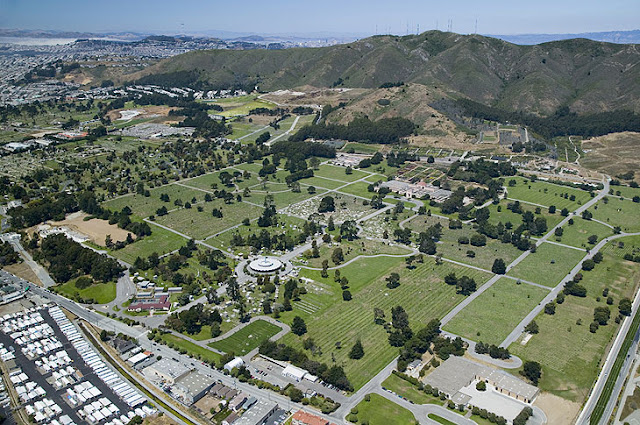Necropolis
A 3.5 mile bike
ride from Munson’s place can get you to Colma, a Bay Area city with 1.5 million
underground residents. When property values began to rise in the early
1900s, the City of San Francisco
Usually while
visiting Munson I’m up early and looking for something to do until 11:30 a.m.
when Munson will climb out of bed to begin preparations for the first race at
Santa Anita. One good option is a fifteen minute walk down to the BART
station at Balboa Park Colma
Photo from landsat.com
Known as the “City
of the Dead,” Colma has 1,500 residents living above the remains of 1,000 times
as many folks who’ve passed on. There are 31 niche cemeteries listed whose
customers are either Greek, Japanese, Chinese, Italian, Serbian, Catholic,
Jewish, Eastern Orthodox, non-sectarian or pets. Everyone that was
unearthed and transferred to Colma appears to have come through none the worse
for wear except H.J.Hartnagle who died in 1875. He was exhumed from the Odd Fellows Cemetery in San
Francisco Holy
Cross Cemetery Colma Historical
Museum
There is a seemingly endless cast of characters for
whom to pay your respects. A large black headstone marks where Wyatt
Earp's ashes are interred in the Jewish section of the Hills of Eternity
Memorial Park. After the gunfight at the
O.K.Corral, Wyatt and several other members of the Earp clan relocated to San Francisco California Arcadia and where Wyatt, an
inveterate horse player, stopped by when he was in Los Angeles Los
Angeles , Hollywood
Photo from stargazemercantile.com
A short walk takes you to Holy Cross Cemetery San Francisco Martinez
Photo by brokensphere
Not far from DiMaggio is a grave marker for
George Moscone who while Mayor of San Francisco was shot dead in his office in
1978 by Dan White, a former member of the board of supervisors. White also shot and killed Harvey Milk who
was the city’s most popular public figure and the first openly gay supervisor
in the history of San Francisco
Photo from cemeteryguide.com
The jurors for White’s trial made O.J.’s Simpson
jurors all seem like Oliver Wendell Holmes.
The outcome of the trial so outraged the public that the State of California San Francisco
For some real heavy hitters you need to
move on to the Cypress
lawn Cemetery
Photo from pinterest.com
William Hearst’s father George was a U.S. Senator
during the latter part of the 1800s and was close friends with Mexico Mexico
I really don’t see what is to
prevent us from owning
all Mexico
What William was unable to see at the time
that prevented Mexico from
becoming the Hearst
Republic
Interestingly, there was another
revolutionary group who many decades later had a run-in with the Hearst
family. In 1974 the Symbionese Liberation
Army (SLA) kidnapped William Randolph Hearst’s nineteen-year-old granddaughter
Patty. To release her the SLA demanded that the Hearst family distribute $70 worth
of food to all Californians in need. It
was estimated that such a deed would have a price tag of $400 million. Patty’s father countered by donating two
million dollars of food to low income areas in Oakland SLA
refused to release her.
Patty remained with the SLA eventually taking
the name “Tania” as an SLA sister. Tania was filmed by security cameras with an
automatic weapon during two separate robberies, and when finally arrested
stated her occupation as “urban guerilla.”
Patty was convicted of bank robbery and instead of the 35 years called
for, received a sentence of seven years.
Her sentence was commuted by President Carter after 22 months and all her
rights were restored twenty years later when President Bill Clinton issued her
a full pardon on his last day in office.
The Hearst Corporation’s campaign contributions have always been a
matter of public record.
Phineas B. Gage’s grave is also at Cypress Lawn Cemetery Harvard Medical School
Photo from yourfascinatinmind.com
Phineas spent the last eight years of his
life as a stage coach driver in Chile
before he returned to California Harvard Medical School
along with the bar where they sit to this day in the Warren Anatomical
Museum
There’s one last stop at the Woodlawn Cemetery San Francisco United States Golden Gate Strait
Photo from justshareit.com
He took to wearing a bold blue uniform with
gold epaulettes, inspecting the condition of sidewalks and cable cars, and
delivering philosophical rants on street corners. Although judged to be partially demented he
was loved and respected by everyone in the city. Police officers saluted him, his meals were
free at even the most expensive restaurants, business owners hung plaques in
their establishments to call attention to him as a customer, and all theatrical
and musical productions always set aside balcony seats for him. Norton shared his free meals with two dogs he
befriended and named Bummer and Lazarus.
When Lazarus passed away Norton went to the funeral dressed as the Pope
and 10,000 residents attended. When
Norton died in 1880, 30,000 people came to the funeral. In 1934 his remains were transferred to Colma
where his headstone reads “Norton I, Emperor of the United
States and Protector of Mexico






